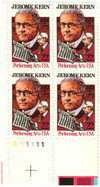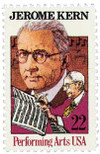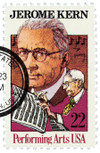
# 2110 - 1985 22c Performing Arts: Jerome Kern
U.S. #2110
1985 22¢ Jerome Kern
Performing Arts
- Stamp celebrated 100th birth anniversary of composer Jerome Kern
- 8th stamp in the Performing Arts Series
Stamp Category: Commemorative
Series: Performing Arts
Value: 22¢, rate for first-class mail
First Day of Issue: January 23, 1985
First Day City: New York, New York
Quantity Issued: 124,500,000
Printed by: American Bank Note Company
Printing Method: Photogravure
Format: Panes of 50 in Sheets of 200
Perforations: 11
Why the stamp was issued: To celebrate the 100th birth anniversary of composer Jerome Kern.
About the stamp design: This stamp was designed by Jim Sharpe, following the same format he used on all previous Performing Arts Series stamps. It features a large portrait of Kern with a smaller, inset image of the composer with sheet music.
First Day City: This stamp’s First Day ceremony was held at the Main Gallery of the New York Public Library at Lincoln Center.
Unusual fact about this stamp: This stamp has been found misperforated, with the horizontal perforations appearing too high on the stamps.
About the Performing Arts Series: The Performing Arts series ran from 1978 to 1987 and honored 12 performers of stage and screen including musicians and actors. Each stamp features a portrait of the performer. Several stamps include a second smaller image of the performer or other elements representative of their careers. Click here for the complete set.
History the stamp represents: Jerome David Kern was born on January 27, 1885, in New York City, New York. Kern had a talent for music from an early age. His mother taught him piano and organ when he was a child. After the family moved to Newark, New Jersey, he wrote the songs for his school’s first musical.
Kern left school before graduating in the hopes of pursing a career in music. His father insisted he work at his business, but after Kern made the costly mistake of ordering 200 pianos instead of two, his father let him follow his dream. Kern joined the New York College of Music in 1902 and published her first composition, At the Casino, that same year.
After college, Kern spent time in England and found work adding new songs to British musicals for use on Broadway. Kern also wrote some songs for British plays. His first complete score was for the Broadway show The Red Petticoat in 1912.
By the start of World War I, Kern had written over 100 songs for about 30 musicals. Kern’s compositions were popular – they worked with the popular foxtrot dance style and incorporated ragtime and jazz elements, making then fresh and modern for the time. Kern may have composed music for silent films as early as 1912, but the first documented music he wrote for a film was the 1916 serial Gloria’s Romance.
In the 1920s, Kern worked on at least one show every year. In 1925, he met Oscar Hammerstein II, who would become a lifelong friend and collaborator. Hammerstein was the only other composer Kern would collaborate with for an extended period of time. He seldom collaborated with other composers for very long.
Following the successes of Sally and Sunny, Kern wanted to take a chance. He had read Edna Ferber’s novel Show Boat and wanted to make it into a musical. The story dealt with racism and alcoholism, which were rarely included in musical comedies. But Kern was permitted to take the chance, and Show Boat would become one of his greatest successes. While the songs from many of his other musicals remained popular on their own, the plays themselves were largely forgotten. But Show Boat has been revived many times and is Kern’s most enduring work. It also included some of his most well-known songs, including “Ol’ Man River,” “Can’t Help Lovin’ Dat Man,” “Make Believe,” and “You Are Love.”
Kern went to Hollywood in 1929 to oversee the film adaptations of Sally, Men of the Sky, and Sunny. Kern composed his last new Broadway show, Very Warm for May, in 1939. After that, he returned to Hollywood to score a number of movies, including I Dream Too Much, Roberta, Lovely to Look At, and Swing Time. Kern’s final film score was for Centennial Summer in 1946. Kern suffered a cerebral hemorrhage and died on November 11, 1945. The following year, a film based loosely on his life, Till the Clouds Roll By, was released.
Over the course of his career, Kern composed more than 1,000 songs and wrote 108 theatrical scores. He was twice the recipient of an Academy Award for music.
U.S. #2110
1985 22¢ Jerome Kern
Performing Arts
- Stamp celebrated 100th birth anniversary of composer Jerome Kern
- 8th stamp in the Performing Arts Series
Stamp Category: Commemorative
Series: Performing Arts
Value: 22¢, rate for first-class mail
First Day of Issue: January 23, 1985
First Day City: New York, New York
Quantity Issued: 124,500,000
Printed by: American Bank Note Company
Printing Method: Photogravure
Format: Panes of 50 in Sheets of 200
Perforations: 11
Why the stamp was issued: To celebrate the 100th birth anniversary of composer Jerome Kern.
About the stamp design: This stamp was designed by Jim Sharpe, following the same format he used on all previous Performing Arts Series stamps. It features a large portrait of Kern with a smaller, inset image of the composer with sheet music.
First Day City: This stamp’s First Day ceremony was held at the Main Gallery of the New York Public Library at Lincoln Center.
Unusual fact about this stamp: This stamp has been found misperforated, with the horizontal perforations appearing too high on the stamps.
About the Performing Arts Series: The Performing Arts series ran from 1978 to 1987 and honored 12 performers of stage and screen including musicians and actors. Each stamp features a portrait of the performer. Several stamps include a second smaller image of the performer or other elements representative of their careers. Click here for the complete set.
History the stamp represents: Jerome David Kern was born on January 27, 1885, in New York City, New York. Kern had a talent for music from an early age. His mother taught him piano and organ when he was a child. After the family moved to Newark, New Jersey, he wrote the songs for his school’s first musical.
Kern left school before graduating in the hopes of pursing a career in music. His father insisted he work at his business, but after Kern made the costly mistake of ordering 200 pianos instead of two, his father let him follow his dream. Kern joined the New York College of Music in 1902 and published her first composition, At the Casino, that same year.
After college, Kern spent time in England and found work adding new songs to British musicals for use on Broadway. Kern also wrote some songs for British plays. His first complete score was for the Broadway show The Red Petticoat in 1912.
By the start of World War I, Kern had written over 100 songs for about 30 musicals. Kern’s compositions were popular – they worked with the popular foxtrot dance style and incorporated ragtime and jazz elements, making then fresh and modern for the time. Kern may have composed music for silent films as early as 1912, but the first documented music he wrote for a film was the 1916 serial Gloria’s Romance.
In the 1920s, Kern worked on at least one show every year. In 1925, he met Oscar Hammerstein II, who would become a lifelong friend and collaborator. Hammerstein was the only other composer Kern would collaborate with for an extended period of time. He seldom collaborated with other composers for very long.
Following the successes of Sally and Sunny, Kern wanted to take a chance. He had read Edna Ferber’s novel Show Boat and wanted to make it into a musical. The story dealt with racism and alcoholism, which were rarely included in musical comedies. But Kern was permitted to take the chance, and Show Boat would become one of his greatest successes. While the songs from many of his other musicals remained popular on their own, the plays themselves were largely forgotten. But Show Boat has been revived many times and is Kern’s most enduring work. It also included some of his most well-known songs, including “Ol’ Man River,” “Can’t Help Lovin’ Dat Man,” “Make Believe,” and “You Are Love.”
Kern went to Hollywood in 1929 to oversee the film adaptations of Sally, Men of the Sky, and Sunny. Kern composed his last new Broadway show, Very Warm for May, in 1939. After that, he returned to Hollywood to score a number of movies, including I Dream Too Much, Roberta, Lovely to Look At, and Swing Time. Kern’s final film score was for Centennial Summer in 1946. Kern suffered a cerebral hemorrhage and died on November 11, 1945. The following year, a film based loosely on his life, Till the Clouds Roll By, was released.
Over the course of his career, Kern composed more than 1,000 songs and wrote 108 theatrical scores. He was twice the recipient of an Academy Award for music.











